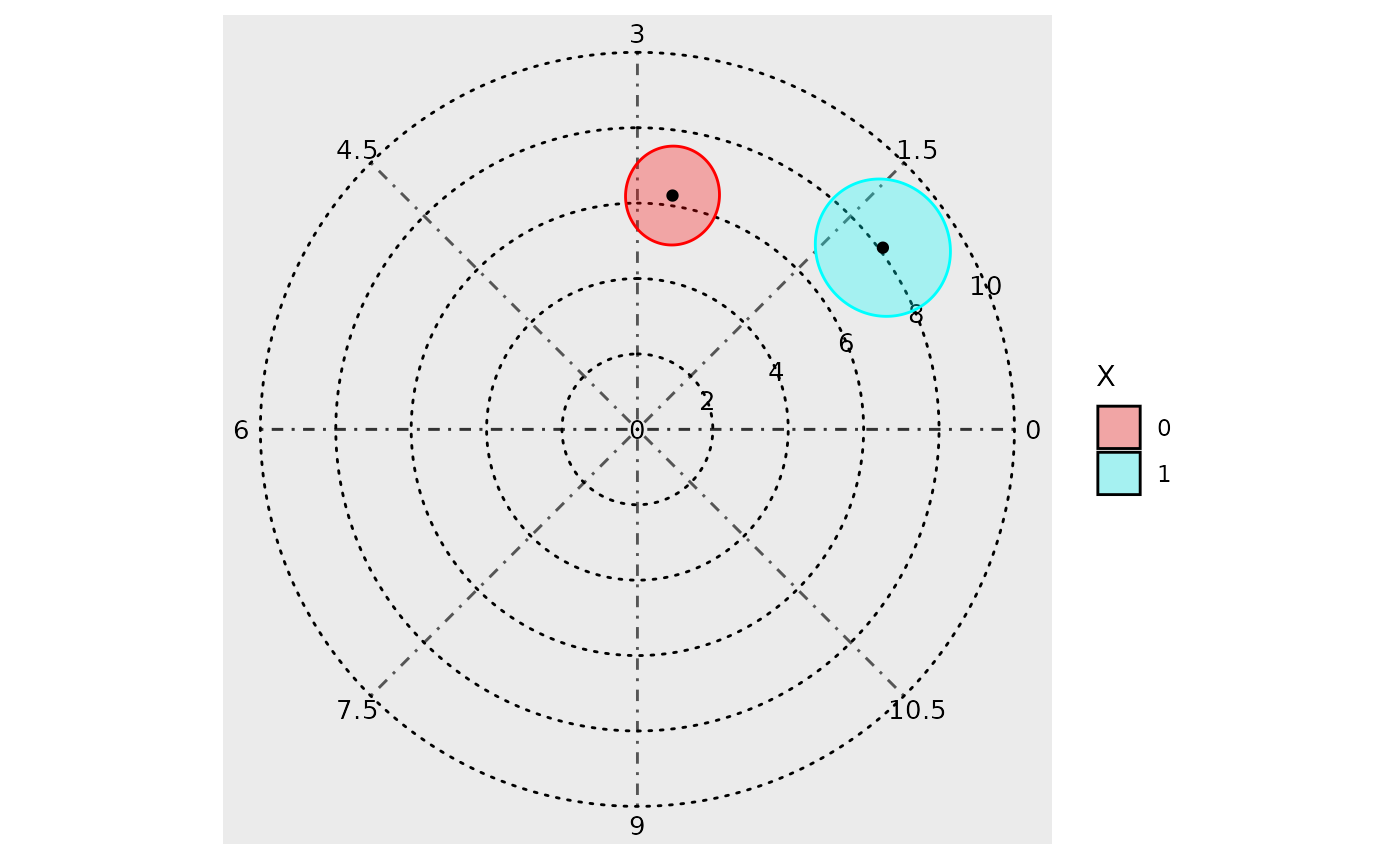
Generates a polar plot with elliptical confidence intervals
Source:R/polar_plot.R
polar_plot.cglmm.RdGenerates a polar plot with elliptical confidence intervals
Usage
# S3 method for class 'cglmm'
polar_plot(
x,
ci_level = 0.95,
n_breaks = 5,
component_index = NULL,
grid_angle_segments = 8,
radial_units = c("radians", "degrees", "period"),
clockwise = FALSE,
text_size = 3.5,
text_opacity = 1,
fill_colors,
ellipse_opacity = 0.3,
circle_linetype = "dotted",
start = c("right", "left", "top", "bottom"),
view = c("full", "zoom", "zoom_origin"),
overlay_parameter_info = FALSE,
quietly = TRUE,
show_component_labels = TRUE,
xlims,
ylims,
...
)Arguments
- x
An object of class
cglmm- ci_level
The level for calculated confidence ellipses. Defaults to 0.95.
- n_breaks
The number of concentric circles that will be plotted using the
scales::breaks_pretty()function. By default, 5 breaks will be used. The number of breaks may be adjusted to result in an even interval. For example, if n_breaks is 3, but the maximum plot radius is 8, instead of plotting circles in intervals in 1.6, this interval will be rounded to 2 to result in the sequence: 0, 2, 4, 6, 8. See?scales::breaks_prettyfor more details.- component_index
A number that corresponds to a particular component from the
cglmm()object that will be used to create polar plot. If missing (default), then plots for all components will be arranged in the returned plot. If a single or multiple values are provided, then these components will be returned. (for examplecomponent_index = 1,component_index = c(1, 3)).- grid_angle_segments
An
integer. Determines the total number of segments in the background of the polar plot. For example, a value of 4 will create quadrants around the origin. Defaults to 8.- radial_units
A
characterspecifying the angular units of the plot. Possible values are one ofc('radians', 'degrees', 'period'). These units relate to the period of the component being visualized.'radians': \([0, 2\pi]\)'degrees': \([0, 360]\)'period': \([0, period]\)
- clockwise
A
logical. IfTRUE, the angles increase in a clockwise fashion. IfFALSE, anti-clockwise. Defaults toFALSE.- text_size
A number controlling the font size of the text labels. Defaults to 3.
- text_opacity
A
numericbetween 0 and 1 inclusive that controls the opacity of the text labels.- fill_colors
A
charactervector containing colors that will be mapped to levels within a group. If the model has components with different number of levels per factor, the length of this input should match the greatest number of levels. If not, or if the number of levels exceeds the length of the default argument (8), colors are generated usingrainbow().- ellipse_opacity
A
numericbetween 0 and 1 inclusive that controls the opacity of the confidence ellipses. Defaults to 0.3.- circle_linetype
A
characterornumericthat determines thelinetypeof the radial circles in background of the polar plot. See?linetypefor more details.- start
A
character, withinc("right", "left", "top", "bottom")that determines where angle 0 is located. Ifstart = "top", andclockwise = TRUE, the angle will rotate clockwise, starting at the '12 o-clock' position on a clock.- view
A
character, withinc("full", "zoom", "zoom_origin")that controls the view of the plots.'full': maintains a full view of the polar plot, including the background radial circles.'zoom': finds the minimum view window which contains all confidence ellipses.'zoom_origin': zooms into the confidence ellipses (like "zoom"), but also keeps the origin within frame.
- overlay_parameter_info
A
logicalargument. IfTRUE, more information about the acrophase and amplitude are displayed on the polar plots.- quietly
Analogous to verbose, this
logicalargument controls whether messages are displayed in the console.- show_component_labels
Logical argument, TRUE by default. When TRUE, the polar plots have labels corresponding to their components.
- xlims
A vector of length two containing the limits for the x-axis.
- ylims
A vector of length two containing the limits for the y-axis.
- ...
Additional, ignored arguments.
Examples
model <- cglmm(
vit_d ~ X + amp_acro(time, group = "X", period = 12),
data = vitamind
)
polar_plot(model, radial_units = "period")
